Eastern Europe
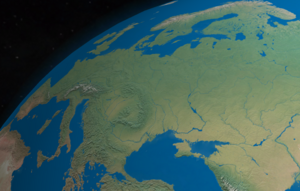
Eastern Europeis a subregion of theEuropean continent.As a largely ambiguous term, it has a wide range of geopolitical, geographical, ethnic, cultural, and socio-economic connotations. Its eastern boundary is marked by theUral Mountains,whilst its western boundary is defined in various ways.[1]Most definitions include the countries ofBelarus,Russia,Ukraine,MoldovaandRomaniawhile less restrictive definitions may also include some or all of theBalkans,theBaltic states,theCaucasusand theVisegrád group.[2][3]
The region represents a significant part ofEuropean culture;the main socio-cultural characteristics of Eastern Europe have historically been defined by the traditions of theEast SlavsandGreeks,as well as by the influence ofEastern Christianityas it developed through theEastern Roman Empireand theOttoman Empire.[4][5]Another definition was created by theCold War,as Europe was ideologically divided by theIron Curtain,with "Eastern Europe" being synonymous withcommunist statesconstituting theEastern Blocunder the influence of theSoviet Union.[5][6][7][8][9][4][10][11]
The term is sometimes considered to be pejorative, through stereotypes about Eastern Europe being inferior (poorer, less developed) toWestern Europe;the termCentral and Eastern Europeis sometimes used for a more neutral grouping.[12][13][14][15][16]
Definitions
[edit]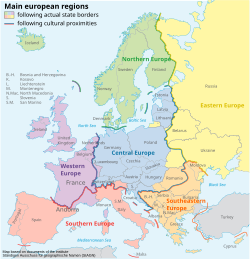
Several definitions of Eastern Europe exist in the early 21st century, but they often lack precision and may be anachronistic. These definitions are debated across cultures and among experts, evenpolitical scientists,[18]as the term has a wide range ofgeopolitical,geographical, cultural, andsocioeconomicconnotations. It has also been described as a "fuzzy" term, as the idea itself of Eastern Europe is in constant redefinition.[19]The solidification of the idea of an "Eastern Europe" dates back chiefly to the (French)Enlightenment.[19]
There are "almost as many definitions of Eastern Europe as there are scholars of the region".[6]A relatedUnited Nationspaper adds that "every assessment of spatial identities is essentially a social andcultural construct".[20]
Geographical
[edit]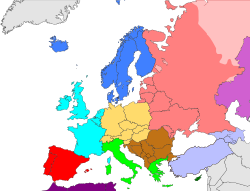
While the eastern geographical boundaries of Europe are well defined, the boundary between Eastern andWestern Europeis not geographical but historical, religious and cultural and is harder to designate.
TheUral Mountains,Ural River,and theCaucasus Mountainsare thegeographical land borderof the eastern edge of Europe. E.g.Kazakhstan,which is mainly located inCentral Asiawith the most western parts of it located west of theUral River,also shares a part of Eastern Europe.
In the west, however, the historical andculturalboundaries of "Eastern Europe" are subject to some overlap and, most importantly, have undergone historical fluctuations, which makes a precise definition of the western geographic boundaries of Eastern Europe and thegeographical midpoint of Europesomewhat difficult.
Religious and cultural influence
[edit]
After theEast–West Schismin 1054, significant parts of Eastern Europe developed cultural unity and resistance to Catholic Western and Central Europe within the framework of theEastern Orthodox Church,Church Slavoniclanguage and theCyrillic alphabet.[21][22][23][24]
A large section ofEastern Europeis formed by countries with dominant Orthodox churches, likeBelarus,Bulgaria,Cyprus,Georgia,Greece,Moldova,Montenegro,North Macedonia,Romania,Russia,Serbia,andUkraine,for instance, as well asArmenia,which is predominantlyArmenian Apostolic.[25][26]TheEastern Orthodox Churchhas played a prominent role in the history and culture of Eastern andSoutheastern Europe.[27]To a lesser degree, forms ofEastern ProtestantismandEastern Catholicismhave also been influential in Eastern Europe. Countries where Eastern Protestantism or Eastern Catholicism hold historical significance include Belarus,Croatia,Greece,Hungary,Lithuania,Poland,Romania, Russia,Slovakia,Sloveniaand Ukraine.[28][29][30]

The schism refers to the historical break of communion andtheologybetween the Eastern (Orthodox) and Western (Catholic) churches. Later developments meant that the divide was no longer solely between Catholic and Orthodox churches. From the 16th century, both Western and Eastern forms of Protestantism began to emerge in Europe.[31][32]Additionally, Eastern Catholic Churches began to spread in Europe during the 16th and 17th centuries, following the establishment of theUkrainian Greek Catholic Churchin 1596.[32][33][34][35]However, the concept of Eastern Catholicism itself predates this.[35]
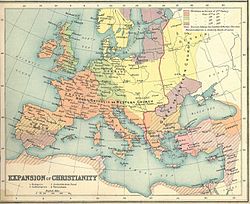
Since the Great Schism of 1054, Europe has been divided betweenCatholic(and later additionallyProtestant) churches in the West, and theEastern Orthodox Christian(often incorrectly labelled "Greek Orthodox" ) churches in the east. Due to this religious cleavage, Eastern Orthodox countries are often associated with Eastern Europe. A cleavage of this sort is, however, often problematic; for example,Greeceis overwhelmingly Orthodox, but is very rarely included in "Eastern Europe", for a variety of reasons, the most prominent being that Greece's history, for the most part, was more influenced by Mediterranean cultures and dynamics.[38]
Cold War (1947–1991)
[edit]Thefall of the Iron Curtainbrought the end of the Cold War east–west division in Europe,[39]but this geopolitical concept is sometimes still used for quick reference by the media.[40]Another definition was used during the 40 years ofCold Warbetween 1947 and 1989, and was more or less synonymous with the termsEastern BlocandWarsaw Pact.A similar definition names the formerlycommunistEuropeanstatesoutside the Soviet Union as Eastern Europe.[5]
Historians and social scientists generally view such definitions as outdated or relegated.[7][6][8][9][10][4][11]Many former Communist states in this region, although their formal alliances were severed by the fall of the Berlin Wall, continued to feel a moral duty to support states that have not been "liberated from the tyranny of capitalism". This shared duty collapsed when most of the former Soviet satellites abandoned socialism and adopted capitalism.[41]
EuroVoc
[edit]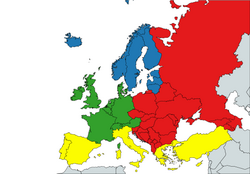
EuroVoc,a multilingualthesaurusmaintained by thePublications Office of the European Union,classifies Bulgaria, Croatia, Czechia, Hungary, Poland, Romania, Slovakia and Slovenia, plus the candidate countries Albania, North Macedonia and Serbia asCentral and Eastern European.[42]
Contemporary developments
[edit]Baltic states
[edit]UNESCO,[43]EuroVoc,National Geographic Society,Committee for International Cooperation in National Research in Demography,and the STW Thesaurus for Economics place the Baltic states inNorthern Europe,whereas the CIA World Factbook places the region in Eastern Europe with a strong assimilation toNorthern Europe.They are members of theNordic-Baltic Eightregional cooperation forum whereas Central European countries formed their own alliance called theVisegrád Group.[44]TheNorthern Future Forum,theNordic Investment Bank,theNordic Battlegroup,theNordic-Baltic Eightand theNew Hanseatic Leagueare other examples ofNorthern Europeancooperation that includes the three countries collectively referred to as the Baltic states.
Caucasus states
[edit]TheSouth Caucasusnations ofArmenia,Azerbaijan,andGeorgia[45]are included indefinitionsor histories of Eastern Europe. They are located in the transition zone of Eastern Europe and Western Asia. They participate in theEuropean Union'sEastern Partnershipprogram, theEuronest Parliamentary Assembly,and are members of theCouncil of Europe,which specifies that all three have political and cultural connections to Europe. In January 2002, theEuropean Parliamentnoted that Armenia and Georgia may enter the EU in the future.[46][47]However, Georgia is currently the only South Caucasus nation actively seeking NATO and EU membership.
There are two de factorepublics with limited recognitionin the South Caucasus region that exist under the presence of Russian military. Both states participate in theCommunity for Democracy and Rights of Nations:
Former republics with limited recognition:
- Chechen Republic of Ichkeria(1991–2000) – existed in former Soviet territory until it was driven into exile during theSecond Chechen War
- Republic of Artsakh(1991–2023) – breakaway state from Azerbaijan that ceased to exist by 1 January 2024[48]
Post-Soviet states
[edit]SomeEuropean republicsof the formerSoviet Unionare considered a part of Eastern Europe:
Central Europe
[edit]The term "Central Europe" is often used by historians to designate states formerly belonging to theHoly Roman Empire,theHabsburg Empire,and thePolish–Lithuanian Commonwealth.
In some media, "Central Europe" can thus partially overlap with "Eastern Europe" of the Cold War Era. The following countries are labelled Central European by some commentators, though others still consider them to be Eastern European.[50][51][52]
- Czech Republic
- Croatia(can variously be included inSoutheastern[53]orCentral Europe)[54]
- Hungary(most often placed inCentral Europebut sometimes inSoutheastern Europe)[55]
- Lithuania(can variously be included inNortheasternorCentral Europe)
- Poland
- Romania(can be included inSoutheastern Europe[56]or partially inCentral Europe)[57]
- Serbia(most often placed inSoutheastern Europebut sometimes partially included inCentral Europe)[58]
- Slovakia
- Slovenia(most often placed inCentral Europebut sometimes inSoutheastern Europe)[59]
Southeastern Europe
[edit]Some countries in Southeast Europe can be considered part of Eastern Europe. Some of them can sometimes, albeit rarely, be characterized as belonging toSouthern Europe,[4]and some may also be included inCentral Europe.
In some media, "Southeast Europe" can thus partially overlap with "Eastern Europe" of the Cold War Era. The following countries are labelled Southeast European by some commentators, though others still consider them to be Eastern European.[60]
- Albania
- Bosnia and Herzegovina
- Bulgaria
- Cyprus(Geographically located in Asia, though most often considered a part ofSoutheastern Europe)
- Croatia(can variously be included inSoutheastern[53]orCentral Europe)[54]
- Greece(Sometimes grouped inSouthern Europewith countries likeItaly,SpainandPortugal)
- Hungary(most often placed inCentral Europebut sometimes inSoutheastern Europe)[61][62]
- Moldova(usually grouped with the non-Baltic post-Soviet states but sometimes considered part ofSoutheastern Europe)[63]
- Montenegro
- North Macedonia
- Romania(can variously be included inSoutheastern[56]orCentral Europe)[57]
- Serbia(mostly placed inSoutheasternbut sometimes inCentral Europe)[58]
- Slovenia(most often placed inCentral Europebut sometimes inSoutheastern Europe)[59][62]
- Turkey(East Thrace,the portion west of theTurkish Straits)
Kazakhstan
[edit]Despite being frequently classified as aCentral Asiancountry, about 4% ofKazakhstan's territory, situated west of theUral River,geographically lies in Eastern Europe, thus technically making it atranscontinental country.[64][65]
History
[edit]It has been suggested that this section besplitout into another article titledHistory of Eastern Europe.(Discuss)(November 2023) |
Classical antiquity and medieval origins
[edit]Ancient kingdoms of the region includedOrontid Armenia,Caucasian Albania,ColchisandIberia(not to be confused with theIberian PeninsulainWestern Europe), of which the former two were the predecessor states ofArmeniaandAzerbaijanrespectively, while the latter two were the predecessor states of modern-dayGeorgia.These peripheral kingdoms were, either from the start or later on, incorporated into various Iranian empires, including theAchaemenid Persian,Parthian,andSassanid PersianEmpires.[66]Parts of theBalkansand some more northern areas were ruled by theAchaemenid Persiansas well, includingThrace,Paeonia,Macedon,and most of theBlack Seacoastal regions ofRomania,Ukraine,andRussia.[67][68]Owing to the rivalry between theParthian EmpireandRome,and later betweenByzantiumand theSassanid Persians,the Parthians would invade the region several times, although it was never able to hold the area, unlike the Sassanids who controlled most of theCaucasusduring their entire rule.[69]

The earliest known distinctions between east and west in Europe originate in the history of theRoman Republic.As the Roman domain expanded, a cultural and linguistic division appeared. The mainlyGreek-speakingeastern provinces had formed the highly urbanizedHellenistic civilization.In contrast, the western territories largely adopted theLatin language.This cultural and linguistic division was eventually reinforced by the later political east–west division of theRoman Empire.The division between these two spheres deepened duringLate Antiquityand theMiddle Agesdue to a number of events. TheWestern Roman Empirecollapsed in the 5th century, marking the start of theEarly Middle Ages.By contrast, the Eastern Roman Empire—theByzantine Empire—had a survival strategy that kept it alive for another 1,000 years.[70]
The rise of theFrankish Empirein the west, and in particular theGreat Schismthat formally dividedEasternandWestern Christianityin 1054, heightened the cultural and religious distinctiveness between Eastern and Western Europe. Much of Eastern Europewas invaded and occupied by the Mongols.[71]
During theOstsiedlung,towns founded underMagdeburg rightsbecame centers of economic development andscattered German settlementswere founded in parts of Eastern Europe.[72]Introduction of German town law is often seen as a second great step after introduction of Christianity at the turn of the first and second millennia. The ensuing modernization of society and economy allowed the increased role played by the rulers ofBohemiaandPoland.[73]
1453 to 1918
[edit]The conquest of theByzantine Empire,center of theEastern Orthodox Church,by theOttoman Empirein the 15th century, and the gradual fragmentation of theHoly Roman Empire(which had replaced the Frankish empire) led to a change of the importance ofCatholic/Protestantvs.Eastern Orthodoxconcept in Europe. Armour points out thatCyrillic-alphabet use is not a strict determinant for Eastern Europe, where from Croatia to Poland and everywhere in between, the Latin alphabet is used.[74]Greece's status as the cradle of Western civilization and an integral part of the Western world in the political, cultural and economic spheres has led to it being nearly always classified as belonging not to Eastern, but Southern or Western Europe.[75]During the late-sixteenth and early-seventeenth centuries, Eastern Europe enjoyed a relatively highstandard of living.This period is also called the east-central European golden age of around 1600.[76]At the beginning of the 17th century,numeracylevels in eastern Europe were relatively low, although regional differences existed. During the 18th century, the regions began to catch up with western Europe, but did not develop as rapidly. Areas with stronger female autonomy developed more quickly in terms of numeracy.[77]
Serfdom
[edit]Serfdomwas a prevalent status of agricultural workers until the 19th century. It resembled slavery in terms of lack of freedom, with the distinction that the landowners could not buy and sell serfs separately from the specific plots of land that they were permanently attached to. The system emerged in the 14th and 15th century, the same time it was declining in Western Europe.[78]The climax came in the 17th and 18th century. The early 19th century saw its decline, marked especially by the abolition of serfdom in Russia in 1861. Emancipation meant that the ex-serfs paid for their freedom with annual cash payments to their former masters for decades. The system varied widely country by country, and was not as standardized as in Western Europe. Historians, until the 20th century, focused on master-serf economic and labor relations, portraying the serfs as slave-like, passive, and isolated. 20th century scholars downplayed the evils and emphasize the complexities.[79][80]
Interwar period (1919–1939)
[edit]A major result of the First World War was the breakup of the Russian, Austro-Hungarian, and Ottoman empires, as well as partial losses to the German Empire. A surge of ethnic nationalism created a series of new states in Eastern Europe, validated by theVersailles Treaty of 1919.Poland was reconstitutedafter thepartitions of the 1790shad divided it between Germany, Austria, and Russia. New countries included Finland, Estonia, Latvia, Lithuania, Ukraine (which wassoon absorbedby the Soviet Union), Czechoslovakia, and Yugoslavia. Austria and Hungary had much-reduced boundaries. The new states included sizeable ethnic minorities, which were to be protected according to theLeague of Nationsminority protection regime.[81]Throughout Eastern Europe, ethnic Germans constituted by far the largest single ethnic minority.[82]In some areas, as in theSudetenland,regions ofPoland,and in parts ofSlovenia,German speakers constituted the local majority, creating upheaval regarding demands of self-determination.
Romania, Bulgaria, and Albania likewise were independent. Many of the countries were still largely rural, with little industry and only a few urban centres. Nationalism was the dominant force but most of the countries had ethnic or religious minorities who felt threatened by majority elements. Nearly all became democratic in the 1920s, but all of them (except Czechoslovakia and Finland) gave up democracy during the depression years of the 1930s, in favor of autocratic, strong-man or single-party states. The new states were unable to form stable military alliances, and one by one were too weak to stand up against Nazi Germany or the Soviet Union, which took them over between 1938 and 1945.
World War II and onset of the Cold War
[edit]Russia ended its participation in the First World War in March 1918 and lost territory, as the Baltic countries and Poland became independent. The region was the main battlefield in the Second World War (1939–45), with German and Soviet armies sweeping back and forth, with millions of Jews and others killed by the Nazis in theGeneralplan Ost,and millions of others killed by disease, starvation, and military action, or executed after being deemed as politically dangerous.[83]During the final stages of World War II the future of Eastern Europe was decided by the overwhelming power of the Soviet Red Army, as it swept the Germans aside. It did not reach Yugoslavia and Albania, however. Finland was free but forced to be neutral in the upcoming Cold War.
Throughout Eastern Europe,German-speaking populationswere expelledto thereduced borders of Germanyin one of the largest ethnic cleansing operations in history.[84]Regions where Germans had formed the local population majority were re-settled with Polish- or Czech-speakers.
The region fell to Soviet control and Communist governments were imposed. Yugoslavia, Albania (and later Romania) had their own Communist regimes independent of Moscow. TheEastern Blocat the onset of the Cold War in 1947 was far behind the Western European countries in economic rebuilding and economic progress. Winston Churchill, in his well-known "Sinews of Peace" address of 5 March 1946, atWestminster CollegeinFulton, Missouri,stressed the geopolitical impact of the "iron curtain":
FromStettinin theBaltictoTriestein theAdriaticaniron curtainhas descended across the Continent. Behind that line lie all the capitals of the ancient states ofCentraland Eastern Europe:Warsaw,Berlin,Prague,Vienna,Budapest,Belgrade,Bucharest,andSofia.
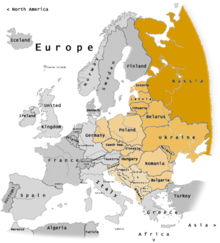
Eastern Bloc
[edit]Eastern Europe after 1945 usually meant all the European countries liberated from Nazi Germany and then occupied by the Soviet army. It included theGerman Democratic Republic(also known as East Germany), formed by theSoviet occupation zoneof Germany. All the countries in Eastern Europe adopted communist modes of control by 1948. These countries were officially independent of the Soviet Union, but the practical extent of this independence was quite limited. Yugoslavia and Albania had Communist control that was independent of the Kremlin.
The communists had a natural reservoir of popularity in that they had destroyed the Nazi invaders.[85]Their goal was to guarantee long-term working-class solidarity. The Soviet secret police, theNKVD,working in collaboration with local communists, created secret police forces using leadership trained in Moscow. This new secret police arrived to arrest political enemies according to prepared lists.[86]The national Communists then took power in a gradualist manner, backed by the Soviets in many, but not all, cases. For a while, cooperative non-Communist parties were tolerated.[87]The Communist governments nationalized private businesses, placing them under state ownership, and monitored the media and churches.[87]When dividing up government offices with coalition partners, the Communists took control of the interior ministries, which controlled the local police.[88]They also took control of the mass media, especially radio,[89]as well as the education system.[90]They confiscated and redistributed farmland,[91]and seized control of or replaced the organizations of civil society, such as church groups, sports, youth groups, trade unions, farmers' organizations, and civic organizations. In some countries, they engaged in large-scale ethnic cleansing, moving ethnic groups such as Germans, Poles, Ukrainians and Hungarians far away from where they previously lived, often with high loss of life, to relocate them within the new post-war borders of their respective countries.[92]
Under Stalin's direct instructions, these nations rejected grants from the AmericanMarshall Plan.Instead, they joined theMolotov Plan,which later evolved into theComecon (Council for Mutual Economic Assistance).WhenNATOwas created in 1949, most countries of Eastern Europe became members of the opposingWarsaw Pact,forming a geopolitical concept that became known as theEastern Bloc.This consisted of:
- First and foremost was theSoviet Union(which included the modern-day territories ofRussia,Belarus,UkraineandMoldovaand the illegally occupiedLithuania,LatviaandEstonia). Other countries dominated by the Soviet Union were theGerman Democratic Republic,People's Republic of Poland,Czechoslovak Socialist Republic,People's Republic of Hungary,People's Republic of Bulgaria,andSocialist Republic of Romania.
- TheSocialist Federal Republic of Yugoslavia(SFRY; formed after World War II and before its later dismemberment) was not a member of theWarsaw Pact.It was a founding member of theNon-Aligned Movement,an organization created in an attempt to avoid being assigned to either the NATO or Warsaw Pact blocs. The movement was demonstratively independent of both the Soviet Union and the Western bloc for most of the Cold War period, allowing Yugoslavia and its other members to act as a business and political mediator between the blocs.[93]
- TheSocialist People's Republic of Albaniabroke with the Soviet Union in the early 1960s as a result of theSino-Soviet split,aligning itself instead with China. Albania formally left the Warsaw pact in September 1968 after the suppression of thePrague Spring.When China established diplomatic relations with the United States in 1978, Albania also broke away from China. Albania and especially Yugoslavia were not unanimously appended to the Eastern Bloc, as they were neutral for a large part of the Cold War period.[94]
Since 1989
[edit]With thefallof theIron Curtainin 1989, the political landscape of theEastern Bloc,and indeed the world, changed. In theGerman reunification,the Federal Republic of Germany peacefully absorbed the German Democratic Republic in 1990. In 1991,COMECON,theWarsaw Pact,and the Soviet Union were dissolved. Many European nations that had been part of the Soviet Union declared or regained their independence (Belarus,Moldova,Ukraine,as well as theBaltic StatesofLatvia,Lithuania,andEstonia).Czechoslovakiapeacefully separatedinto theCzech RepublicandSlovakiain 1993. Many countries of this region joined theEuropean Union,namelyBulgaria,theCzech Republic,Croatia,Estonia,Hungary,Latvia, Lithuania,Poland,Romania,SlovakiaandSlovenia.The term "EU11 countries" refer to theCentraland Eastern European member states, including theBaltic states,that accessed in 2004 and after: in 2004 the Czech Republic, Estonia, Latvia, Lithuania, Hungary, Poland, Slovenia, and the Slovak Republic; in 2007 Bulgaria, Romania; and in 2013 Croatia.
The economic changes were in harmony with the constitutional reforms: constitutional provisions on public finances can be identified and, in some countries, a separate chapter deals with public finances. Generally, they soon encountered the following problems: high inflation, high unemployment, low economic growth, and high government debt. By 2000 these economies were stabilized, and between 2004 and 2013 all of them joined the European Union. Most of the constitutions define directly or indirectly the economic system of the countries parallel to the democratic transition of the 1990s: free-market economy (sometimes complemented with the socially [and ecologically] oriented sector), economic development, or only economic rights are included as a ground for the economy.[95]
In the case of fiscal policy, the legislative, the executive and other state organs (Budget Council, Economic and Social Council) define and manage the budgeting. The average government debt in the countries is nearly 44%, but the deviation is great because the lowest figure is close to 10% but the highest is 97%. The trend shows that the sovereign debt ratio to GDP in most countries has been rising. Only three countries are affected by high government debt: Croatia, Hungary and Slovenia (over 70% of the GDP), while Slovakia and Poland fulfill the Maastricht requirement but only 10% below the threshold. The contribution to cover the finances for common needs is declared, the principle of just tax burden-sharing is supplemented sometimes with special aspects. Tax revenues expose typically 15–19 % of the GDP, and rates above 20% only rarely can be found.[95]
The state audit of the government budget and expenditures is an essential control element in public finances and an important part of the concept of checks and balances. The central banks are independent state institutions, which possess a monopoly on managing and implementing a state's or federation's monetary policy. Besides monetary policy, some of them even perform the supervision of the financial intermediary system. In the case of a price stability function, the inflation rate, in the examined area, relatively quickly dropped to below 5% by 2000. In monetary policy the differences are based on the euro-zone: Estonia, Latvia, Lithuania, Slovakia, Slovenia use the common currency. The economies of this decade – similar to the previous one – show a moderate inflation. As a new phenomenon, a slight negative inflation (deflation) appeared in this decade in several countries (Croatia, Estonia, Hungary, Poland, Romania, Slovakia, and Slovenia), which demonstrates sensitivity regarding international developments. The majority of the constitutions determine the national currency, legal tender or monetary unit. The local currency exchange rate to the U.S. dollar shows that drastic interventions were not necessary. National wealth or assets are the property of the state or local governments and, as an exclusive property, the management and protection of them aim at serving the public interest.[95]
Demographics
[edit]
See also
[edit]- Community for Democracy and Rights of Nations
- Eastern European Group
- Eastern Partnership
- Enlargement of the European Union
- Eurasian Economic Union
- Euronest Parliamentary Assembly
- European Union
- European Russia
- Eurovoc
- Future enlargement of the European Union
- Geography of the Soviet Union
- Intermarium
- List of Intangible Cultural Heritage elements in Eastern Europe
- List of political parties in Eastern Europe
- Organization of the Black Sea Economic Cooperation
- Post-Soviet States
- European subregions
- Eurovoc#Eastern Europe
- East-Central Europe
- Central Europe
- Central and Eastern Europe
- Northern Europe
- Southeast Europe
- Western Europe
- Geographical midpoint of Europe
- Regions of Europe
References
[edit]- ^"Regions of Europe: Eastern Europe".10 May 2021.Archivedfrom the original on 25 November 2023.Retrieved1 June2023.
- ^Berglee, Royal (2016)."Traditional Regions of Europe".University of Minnesota.Archivedfrom the original on 2023-12-16.Retrieved2023-12-15.
- ^"Geographic Regions".U.N. Statistics Division.Archivedfrom the original on 2017-08-30.Retrieved2023-10-06.
- ^abcde"United Nations Statistics Division- Standard Country and Area Codes Classifications (M49)-Geographic Regions".Archivedfrom the original on 2017-08-30.Retrieved2017-08-04.
- ^abcRamet, Sabrina P. (1998).Eastern Europe: politics, culture, and society since 1939.Indiana University Press.p. 15.ISBN978-0253212566.Archivedfrom the original on 30 March 2024.Retrieved5 October2011.
- ^abc"The Balkans"Archived10 December 2017 at theWayback Machine,Global Perspectives: A Remote Sensing and World Issues Site.Wheeling Jesuit University/Center for Educational Technologies, 1999–2002.
- ^ab""Eastern Europe" Wrongly labelled ".The Economist.7 January 2010.Archivedfrom the original on 11 February 2021.Retrieved20 February2020.
- ^ab"A New Journal for Central Europe".www.ce-review.org.Archived fromthe originalon 31 October 2017.Retrieved31 August2009.
- ^abFrank H. Aarebrot (14 May 2014).The handbook of political change in Eastern Europe.Edward Elgar Publishing. pp. 1–.ISBN978-1-78195-429-4.Archivedfrom the original on 30 March 2024.Retrieved17 July2017.
- ^ab[1]Archived3 April 2015 at theWayback Machine.Eurovoc.europa.eu. Retrieved on 4 March 2015.
- ^abc"Population Division, DESA, United Nations: World Population Ageing 1950-2050"(PDF).Archived(PDF)from the original on 2022-10-09.
- ^Mälksoo, Maria (4 May 2019)."The normative threat of subtle subversion: the return of 'Eastern Europe' as an ontological insecurity trope".Cambridge Review of International Affairs.32(3): 365–383.doi:10.1080/09557571.2019.1590314.ISSN0955-7571.S2CID159184190.Archivedfrom the original on 2024-03-30.Retrieved2022-11-16.
- ^Twardzisz, Piotr (25 April 2018).Defining 'Eastern Europe': A Semantic Inquiry into Political Terminology.Springer. p. 18.ISBN978-3-319-77374-2.Archivedfrom the original on 2023-06-29.Retrieved2023-01-03.
- ^Hall, Derek (July 1999)."Destination branding, niche marketing and national image projection in Central and Eastern Europe".Journal of Vacation Marketing.5(3): 227–237.doi:10.1177/135676679900500303.ISSN1356-7667.S2CID154698941.
- ^Zarycki, Tomasz (2014).Ideologies of Eastness in Central and Eastern Europe.doi:10.4324/9781315819006.ISBN9781317818571.S2CID129401740.Archivedfrom the original on 2022-11-16.Retrieved2022-11-16.
- ^"Eastern promise and Western pretension – DW – 09/07/2018".dw.com.Archivedfrom the original on 2022-11-16.Retrieved2022-11-16.
- ^Jordan, Peter (2005)."Großgliederung Europas nach kulturräumlichen Kriterien"[The large-scale division of Europe according to cultural-spatial criteria].Europa Regional.13(4). Leipzig: Leibniz-Institut für Länderkunde (IfL): 162–173.Archivedfrom the original on 27 December 2023.Retrieved21 January2019– via Ständiger Ausschuss für geographische Namen (StAGN).
- ^Drake, Miriam A. (2005) Encyclopedia of Library and Information Science,CRC Press
- ^abGrob, Thomas (February 2015)."The concept of" Eastern Europe "in past and present".UNI NOVA.University of Basel.Archivedfrom the original on 2020-11-26.Retrieved2020-09-04.
- ^"Jordan Europa Regional".4 April 2014. Archived fromthe originalon 4 April 2014.
- ^Magocsi, Paul Robert(2002)."Chapter 11".Historical Atlas of Central Europe(Rev. and expanded ed.). University of Toronto Press.ISBN978-0-8020-8486-6.OCLC150672781.Archivedfrom the original on 2024-03-30.Retrieved2023-02-10.
- ^Kasper von Greyerz (2007).Religion and Culture in Early Modern Europe.Oxford University Press. pp. 38–.ISBN978-0-19-804384-3.Archivedfrom the original on 2024-03-30.Retrieved2022-01-06.
- ^Jean W Sedlar (1994).East Central Europe in the Middle Ages, 1000–1500.University of Washington Press. p. 161.ISBN0-295-97291-2.Archivedfrom the original on 2024-03-30.Retrieved2022-01-06.
- ^Dumitran, Adriana (2010)."Uspořádání Evropy – duch kulturní jednoty na prahu vzniku novověké Evropy"[The shape of Europe. The spirit of unity through culture in the eve of Modern Europe] (in Czech).Czech Republic:Bibliography of the History of the Czech Lands, The Institute of History,Academy of Sciences of the Czech Republic.Archivedfrom the original on 2016-05-18.Retrieved2022-01-06.
- ^"Religious Belief and National Belonging in Central and Eastern Europe".Pew Research Center.May 10, 2017.Archivedfrom the original on September 18, 2018.RetrievedJanuary 30,2020.
- ^"The History of Georgian Orthodox Church".www.atlantaserbs.com.Archivedfrom the original on 2021-03-04.Retrieved2021-02-07.
- ^Ware, Bishop Kallistos (Timothy)(29 April 1993),The Orthodox Church(new ed.), New York: Penguin Books, p. 8,ISBN978-0-14-014656-1
- ^"Eastern rite church | History, Beliefs & Practices | Britannica".www.britannica.com.Archivedfrom the original on 2024-01-19.Retrieved2024-02-28.
- ^Fernández Rodríguez, José Manuel (28 November 2016). "Eastern Protestant and Reformed Churches" a historical and ecumenical look "".Theologica Xaveriana.66 (182): 345–366.doi:10.11144/javeriana.tx66-182.ioproh.
- ^Milovanović, Aleksandra Djurić; Radić, Radmila (2017-10-11). "Parts I, II, III".Orthodox Christian Renewal Movements in Eastern Europe.Springer.ISBN978-3-319-63354-1.
- ^Parushev, Parush; Apollo, Toivo (2004). McGrath, Alister E.; Marks, Darren C. (eds.).The Blackwell Companion to Protestantism.Blackwell Publishing Ltd. pp. 155–160.doi:10.1002/9780470999196.ISBN978-0-631-23278-0.Archivedfrom the original on 2024-02-28.Retrieved2024-02-28.
- ^abNichols, Aidan (2010).Rome and the Eastern Churches: A Study in Schism(2nd ed.). Ignatius Press. pp. 13–19.ISBN9781586172824.
- ^Galadza, Peter (2007-07-04). Parry, Ken (ed.).The Blackwell Companion to Eastern Christianity.Blackwell Publishing Ltd. pp. 291–309.doi:10.1002/9780470690208.ISBN978-0-631-23423-4.Archivedfrom the original on 2024-02-28.Retrieved2024-02-28.
- ^"Union of Brest-Litovsk | Polish-Soviet, Treaty, 1918 | Britannica".www.britannica.com.Archivedfrom the original on 2023-06-29.Retrieved2024-02-28.
- ^ab"Eastern rite church | History, Beliefs & Practices | Britannica".www.britannica.com.Archivedfrom the original on 2024-01-19.Retrieved2024-02-28.
- ^"Atlas of the Historical Geography of the Holy Land".Rbedrosian.com. Archived fromthe originalon 10 June 2013.Retrieved23 February2013.
- ^"home.comcast.net".Archived fromthe originalon 13 February 2013.Retrieved23 February2013.
- ^Peter John, Local Governance in Western Europe, University of Manchester, 2001,ISBN9780761956372
- ^V. Martynov, The End of East-West Division But Not the End of History, UN Chronicle, 2000 (available online)
- ^"Migrant workers: What we know".BBC News.21 August 2007.Archivedfrom the original on 14 November 2020.Retrieved27 January2009.
- ^Angell, Sam."Risen Consciousness?".www.wilsoncenter.org.The Wilson Center.Retrieved1 April2024.
- ^"Concept: 914 Central and Eastern Europe".EuroVoc.Publications Office of the EU.Archivedfrom the original on 27 October 2023.Retrieved16 July2023.
- ^Division, United Nations Statistics."UNSD — Methodology".unstats.un.org.Archivedfrom the original on 2017-08-30.Retrieved2017-08-04.
- ^"About the Visegrad Group".Visgradgroup.eu.15 August 2006.Archivedfrom the original on 2011-09-25.Retrieved30 July2021.
- ^"Department for General Assembly and Conference Management |".www.un.org.Archivedfrom the original on 2021-04-19.Retrieved2021-04-25.
- ^How Armenia Could Approach the European Union(PDF),archived fromthe original(PDF)on 28 April 2008,retrieved27 February2017
- ^European Parliament on the European Union's relations with the South Caucasus,archivedfrom the original on 2020-07-02,retrieved2020-07-02
- ^Sauer, Pjotr (28 September 2023)."Nagorno-Karabakh's breakaway government says it will dissolve itself".The Guardian.Archivedfrom the original on 15 November 2023.Retrieved28 September2023.
- ^Simic, Predrag (2001). "Do the Balkans Exist? Visions of the Future of Southeastern Europe: Perspectives from the Region".Medzinárodné otázky.10(1). Research Center of the Slovak Foreign Policy Association: 19–39.JSTOR44963345.
- ^Wallace, W.The Transformation of Western EuropeLondon, Pinter, 1990
- ^Huntington, SamuelThe Clash of CivilizationsSimon & Schuster, 1996
- ^Johnson, LonnieCentral Europe: Enemies, Neighbours, FriendsOxford University Press, US, 2001
- ^ab"Croatia".The World Factbook.Central Intelligence Agency. 18 January 2022.Archivedfrom the original on Feb 19, 2024.
- ^abLonnie Johnson,Central Europe: Enemies, Neighbors, Friends,Oxford University Press
- ^"Southeast European Cooperative Initiative (SECI)"(PDF).United Nations Economic Commission for Europe.2003.Archived(PDF)from the original on 2023-10-21.Retrieved2023-10-10.
- ^ab"U.S. Energy Information Administration (EIA)".www.eia.gov.Archived fromthe originalon February 5, 2009.
- ^ab"7 Invitees - Romania".www.nato.int.Archivedfrom the original on 2023-10-29.Retrieved2021-04-25.
- ^abSteven Tötösy de Zepetnek; Louise Olga Vasvári (2011).Comparative Hungarian Cultural Studies.Purdue University Press.ISBN9781557535931.Archivedfrom the original on 2024-03-30.Retrieved2020-11-10.
- ^abArmstrong, Werwick; Anderson, James (2007)."Borders in Central Europe: From Conflict to Cooperation".Geopolitics of European Union Enlargement: The Fortress Empire.Routledge. p. 165.ISBN978-1-134-30132-4.Archivedfrom the original on 2024-03-30.Retrieved2016-03-10.
- ^Bideleux and Jeffries (1998)A History of Eastern Europe: Crisis and Change
- ^Hötte, Hans; Mihalik, Béla (2016).Atlas of Southeast Europe.Boston: Brill.
- ^ab"Police Cooperation Convention for Southeast Europe (PCC SEE)"Archived2024-01-24 at theWayback Machine.PCC SEE Secretariat.Retrieved 20 December 2023.
- ^"A List of Countries That Make up the Balkan Peninsula".www.ThoughtCo.com.Archivedfrom the original on 2017-10-14.Retrieved2020-01-14.
- ^Porter, Malcolm; Lye, Keith (2008).Asia.Cherrytree Books. p. 14.ISBN978-1-84234-461-3.Archivedfrom the original on 12 January 2022.Retrieved11 October2021.
- ^World Factbook.Washington, D.C.:Central Intelligence Agency.29 September 2021.Archivedfrom the original on 9 January 2021.Retrieved23 January2021.Kazakhstan: Geography
- ^Rapp, Stephen H. (2003),Studies In Medieval Georgian Historiography: Early Texts And Eurasian Contexts,pp. 292-294. Peeters BvbaISBN90-429-1318-5.
- ^The Oxford Classical Dictionary by Simon Hornblower and Antony Spawforth,ISBN0-19-860641-9,"page 1515," The Thracians were subdued by the Persians by 516 "
- ^Roisman, Joseph; Worthington, Ian (7 July 2011).A Companion to Ancient Macedonia.John Wiley & Sons.ISBN9781444351637.Archivedfrom the original on 30 March 2024.Retrieved22 April2015.
- ^Olson, James Stuart; Pappas, Lee Brigance; Pappas, Nicholas Charles; Pappas, Nicholas C. J. (1994).An Ethnohistorical Dictionary of the Russian and Soviet Empires.Bloomsbury Academic.ISBN9780313274978.Archivedfrom the original on 30 March 2024.Retrieved22 April2015.
- ^Edward Luttwak,The grand strategy of the Byzantine Empire(Harvard UP, 2009).
- ^Denis Sinor, "The Mongols in the West."Journal of Asian History33.1 (1999): 1-44onlineArchived2021-07-09 at theWayback Machine.
- ^Martyn Rady, "The German Settlement in Central and Eastern Europe during the High Middle Ages." inThe German Lands and Eastern Europe(Palgrave Macmillan, 1999) pp. 11-47.
- ^Jan M. Pisorski (2008). "Medieval Colonization in East Central Europe". In Ingrao; Szabo (eds.).The Germans and the East.Purdue University Press. p. 31.
- ^Armour, Ian D. 2013.A History of Eastern Europe 1740–1918: Empires, Nations and Modernisation.London: Bloomsbury Academic. p. 23.ISBN978-1849664882
- ^See,inter alia,Norman Davies, Europe: a History, 2010, Eve Johansson, Official Publications of Western Europe, Volume 1, 1984, Thomas Greer and Gavin Lewis, A Brief History of the Western World, 2004
- ^ Baten, Jörg (2016).A History of the Global Economy. From 1500 to the Present.Cambridge University Press. p. 46.ISBN9781107507180.
- ^Baten, Joerg; Szołtysek, Mikołaj (2017). ""Girl Power" in Eastern Europe? The human capital development of Central-Eastern and Eastern Europe in the seventeenth to nineteenth centuries and its determinants ".European Review of Economic History.21(1): 29–63.
- ^Jerome Blum,"The Rise of Serfdom in Eastern Europe"American Historical Review62#4 (1957), pp. 807-836OnlineArchived2020-02-07 at theWayback Machine
- ^Boris B. Gorshkov, "Serfdom: Eastern Europe" in Peter Stearns, ed.,Encyclopedia of European Social History(2001) 2:379-88;OnlineArchived2024-03-30 at theWayback Machine.
- ^David Moon, "Reassessing Russian Serfdom."European History Quarterly26 (1996): 483–526.
- ^P. de Azcarate,League of Nations and National Minorities(1945)online
- ^R. M. Douglas.Orderly and Humane. The Expulsion of the Germans after the Second World War.Yale University Press. p. 331.
- ^Timothy Snyder,Bloodlands: Europe Between Hitler and Stalin(2011)excerpt and text searchArchived2017-09-19 at theWayback Machine
- ^Gregor Thum.Uprooted: How Breslau Became Wroclaw during the Century of Expulsions.Princeton University Press.
- ^Applebaum, pp. 312–33.
- ^Anne Applebaum,Iron Curtain: The Crushing of Eastern Europe, 1944–1956(2012) p. xxix.
- ^abApplebaum, p. xxx
- ^Applebaum, p. 71.
- ^Applebaum, pp. 174–191.
- ^Applebaum, pp. 172–173.
- ^Applebaum, pp. 223–228.
- ^Applebaum, pp. 1162–147.
- ^Jeronim Perović, "The Tito-Stalin split: a reassessment in light of new evidence."Journal of Cold War Studies9.2 (2007): 32-63onlineArchived2022-07-04 at theWayback Machine.
- ^Stavro Skendi, "Albania and the Sino-Soviet Conflict."Foreign affairs40.3 (1962): 471-478.
- ^abcVértesy, László (2018)."Macroeconomic Legal Trends in the EU11 Countries"(PDF).Public Governance, Administration and Finances Law Review.3. No. 1. 2018. Archived fromthe original(PDF)on 12 August 2019.Retrieved12 August2019.
Further reading
[edit]- Applebaum, Anne.Iron Curtain: The Crushing of Eastern Europe, 1944–1956(2012)
- Berend, Iván T.Decades of Crisis: Central and Eastern Europe before World War II(2001)
- Connelly, John (2020).From Peoples Into Nations: A History of Eastern Europe.Princeton University Press.ISBN978-0-691-16712-1.
- Day, Alan J. et al.A Political and Economic Dictionary of Eastern Europe(2nd ed 2007)abstract
- Donert, Celia, Emily Greble, and Jessica Wardhaugh. "New Scholarship on Central and Eastern Europe."Contemporary European History26.3 (2017): 507-507. DOI:New Scholarship on Central and Eastern EuropeArchived2024-03-30 at theWayback Machine
- Frankel, Benjamin.The Cold War 1945-1991. Vol. 2, Leaders and other important figures in the Soviet Union, Eastern Europe, China, and the Third World(1992), 379pp of biographies.
- Frucht, Richard, ed.Encyclopedia of Eastern Europe: From the Congress of Vienna to the Fall of Communism(2000)
- Fuchs-Schündeln, Nicola, and Matthias Schündeln. "The long-term effects of communism in Eastern Europe."Journal of Economic Perspectives34.2 (2020): 172–91.onlineArchived2021-06-24 at theWayback Machine
- Gal, Susan and Gail Kligman,The Politics of Gender After Socialism(Princeton University Press, 2000).
- Gorshkov, Boris B. "Serfdom: Eastern Europe." inEncyclopedia of European Social History,edited by Peter N. Stearns, (vol. 2: 2001), pp. 379–388.OnlineArchived2024-03-30 at theWayback Machine
- Ghodsee, Kristen R.Lost in Transition: Ethnographies of Everyday Life After Communism(Duke University Press, 2011).
- Held, Joseph, ed.The Columbia History of Eastern Europe in the Twentieth Century(1993)
- Jeffries, Ian, and Robert Bideleux.The Balkans: A Post-Communist History(2007).
- Jelavich, Barbara(1983a).History of the Balkans: Eighteenth and Nineteenth Centuries.Vol. 1. Cambridge University Press.ISBN9780521274586.Archivedfrom the original on 2023-01-23.Retrieved2021-07-05.
- Jelavich, Barbara.History of the Balkans, Vol. 1: Eighteenth and Nineteenth Centuries(1983)
- Jelavich, Barbara(1983b).History of the Balkans: Twentieth Century.Vol. 2. Cambridge University Press.ISBN9780521274593.
- Mazower, Mark (2007).The Balkans: A Short History.Random House Publishing Group.ISBN978-0-307-43196-7.
- Myant, Martin; Drahokoupil, Jan (2010).Transition Economies: Political Economy in Russia, Eastern Europe, and Central Asia.Wiley-Blackwell.ISBN978-0-470-59619-7.
- Nachtigal, Reinhard. "Current Historiography on Eastern Europe during the First World War: A Review."War & Society41.4 (2022): 323–339. doi.org/10.1080/07292473.2022.2117908
- Ramet, Sabrina P.Eastern Europe: Politics, Culture, and Society Since 1939(1999)
- Roskin, Michael G.The Rebirth of East Europe(4th ed. 2001); 204pp
- Schenk, Frithjof Benjamin,Mental Maps: The Cognitive Mapping of the Continent as an Object of Research of European HistoryArchived2021-01-15 at theWayback Machine,EGO - European History OnlineArchived2013-02-08 at theWayback Machine,Mainz:Institute of European HistoryArchived2016-02-19 at theWayback Machine,2013, retrieved: March 4, 2020 (pdfArchived2022-01-24 at theWayback Machine).
- Schevill, Ferdinand.The History of the Balkan Peninsula; From the Earliest Times to the Present Day(1966)
- Seton-Watson, Hugh.Eastern Europe Between the Wars 1918-1941(1945)online
- Simons, Thomas W.Eastern Europe in the Postwar World(1991)
- Snyder, Timothy.Bloodlands: Europe Between Hitler and Stalin(2011)
- Stanković, Vlada, ed. (2016).The Balkans and the Byzantine World before and after the Captures of Constantinople, 1204 and 1453.Lexington Books.ISBN978-1-4985-1326-5.Archivedfrom the original on 2024-03-30.Retrieved2021-07-05.
- Stavrianos, L.S.The Balkans Since 1453(1958), major scholarly history;online free to borrow
- Swain, Geoffrey and Nigel Swain,Eastern Europe Since 1945(3rd ed. 2003)
- Verdery, Katherine.What Was Socialism and What Comes Next?Princeton: Princeton University Press, 1996.
- Wachtel, Andrew Baruch (2008).The Balkans in World History.Oxford University Press.ISBN978-0-19-988273-1.
- Walters, E. Garrison.The Other Europe: Eastern Europe to 1945(1988) 430pp; country-by-country coverage
- Wolchik, Sharon L. and Jane L. Curry, eds.Central and East European Politics: From Communism to Democracy(2nd ed. 2010), 432pp
- Wolff, Larry:Inventing Eastern Europe: The Map of Civilization on the Mind of the Enlightenment.Stanford: Stanford University Press, 1994.ISBN0-8047-2702-3
- Eastern Europe Unmapped: Beyond Borders and Peripheries(1 ed.). Berghahn Books. 2020.doi:10.2307/j.ctvw049zd.ISBN978-1-78533-685-0.JSTORj.ctvw049zd.




